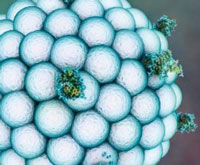| Nov 30, 2012 | |
Nanotechnology consumer database with risk information launched |
|
| (Nanowerk News) The Danish Consumer Council and the Danish Ecological Council has in cooperation with DTU Environment developed a database, which help consumers identify more than 1,200 products that may contain nanomaterials. The Nanodatabase gives consumers a choice. | |
| Nano is used every day | |
 Nanomaterials are used in ordinary consumer products such as cosmetics, clothes and dietary supplements, but no one has a clear overview of where the nanomaterials are used or in which quantities. Nanotechnology is viewed as having bright and great potential when it comes to e.g. cancer research and pollution cleanup. Unfortunately there are also signs of a darker side to nanotechnology. Animal tests have shown that the use of certain nanoparticles can cause problems for our health and environment. Nanotechnology is uncharted waters Nanotechnology is still a relatively new field and even though nanomaterials are used in everyday products we still do not know the potential harmful effects of using nanotechnology. |
|
| ”We are concerned that the flawed legislation means that too many nanomaterials are introduced to the market, before we know the full effects on humans and the environment”, says Lone Mikkelsen, chemical expert from the Danish Ecological Council. | |
| The Nanodatabase helps the consumers | |
| Today the producers of products containing nanomaterials have no obligation to declare their products. In the view of the Danish Consumer Council and the Danish Ecological Council this is a big problem. | |
| ”Most consumers have no idea if there are nanomaterials or not in the goods they’re buying. And they have no way of finding out, so that they can avoid the products if they are worried about the potentially harmful effects” says Claus Jørgensen, Senior Advisor at the Danish Consumer Council. | |
| This is why the Danish Ecological Council and the Danish Consumer Council in cooperation with experts from DTU Environment has decided to launch the Nanodatabase. Now consumers can search the database to see if a certain product contains nanomaterials or is marketed as ‘nano’. This way the consumers can choose if they want the nanomaterials or not. | |
| The database contains more than 1,200 products which contain nanomaterials or are marketed using the nano-claim. | |
| Nanotechnology has potential – but we do not know if there are harmful effects | |
| "We still do not know the possible health effects related to the use of nanotechnology in consumer goods. At the same time we acknowledge that this is a technology that opens up for potential benefits when it comes to the challenges we as a society are facing e.g. food safety, medicine and energy”, says Claus Jørgensen. | |
| There are both pro’s and con’s to nanotechnology, but because of the lack of obligatory labelling consumers cannot make an informed choice. This might create uncertainty among consumers, which can further damage the reputation of nanotechnology. | |
| Nano labelling should be mandatory | |
| The Danish Consumer Council and the Danish Ecological Council emphasizes the necessity of having a mandatory nano-label. And it’s already happening. From the summer of 2013 all cosmetic products containing nanomaterials have to be labelled. And the EU has decided to label nano used in biocides. This will increase transparency for consumers as to where nanomaterials are used, but we need labelling across the board, not just for some sectors. | |
| “Until we know for sure that the use of nanotechnology is safe and the legislation is in place, we need a label that can help consumers make informed choices”, says Lone Mikkelsen. | |
| The two organisations hope that the English version of the database will help consumers in other countries. The hope is that consumers will report products that contain ‘nano’ or claim to be a nano product to the database. |
| Source: DTU, Danish Consumer Council, Danish Ecological Council |
